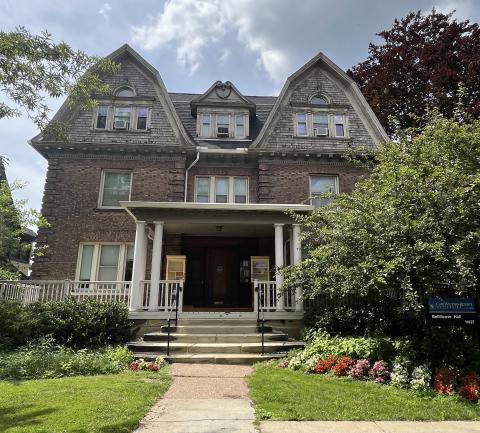The house at 11427 Bellflower was built in 1902 by F. S. Barnum & Co. (a major designer of schools in Cleveland, including John Hay High) as a residence for Henry F. Lyman, president of Cleveland Block Co. and vice president for Upson and Walton Co., ship’s chandler. Lyman and his family, including a wife, a son, and a daughter, lived in the residence less than a decade, however, eventually moving to a home on Cornell Rd.
By 1910, the home had passed into the ownership of Fred W. Gehring, heir to the Gehring Brewery, first president of the Cleveland & Sandusky Brewing Company, and president of a Cleveland bank (likely American Trust). Gehring’s family included his wife Emma, four daughters, and a son. The family was attended by four servants in residence (three women and a man). The house in these years was a vibrant social space, and youngest daughter Clara regularly hosted musical (and Bryn Mawr alumnae) events in the house. Fred Gehring died in 1925; his funeral was held in the home. Emma Gehring’s father’s funeral was also held in the family home in 1929. By 1940, Emma was living in the house with two of her daughters and two female servants. During its existence as a family home, it had five bedrooms and three baths on the second floor, and two servants’ rooms and one bath on the third floor. It featured “a large music room with a magnificent pipe organ.”
The house ceased its life as a family residence in 1944, when it was sold to Mrs. Mary E. Drum who lived in the house and ran a nursing home there until her death in 1949. The Drum nursing home continued under her name into the 1950s. By 1958, ownership passed to the Benjamin Rose Institute, and the house was called “Juniper House” and operated as a 24-hour nursing facility. Through much of the 1960s, it served as the Delta Kappa Epsilon fraternity house.
In January 1972, the New Gallery of Contemporary Art moved from its first Euclid Avenue storefront location into the building. The move coincided with a blockbuster exhibition featuring Christo, who wrapped the old storefront and provided models and exhibits in the new space. Renamed the Cleveland Center for Contemporary Art in 1984 at an event featuring Joan Mondale, the Center exhibited work ranging from Buckminster Fuller’s “Tetrascroll” (a three-dimensional book) to Keith Haring’s graffiti art. When the gallery moved to the Cleveland Playhouse building in 1990, the East Side/West Side Cooperative Gallery moved into the Bellflower space, which later hosted the Infusion Gallery.
In the late 1990s Case Western Reserve University assumed ownership of the building and in 1999 the Writing Resource Center moved from Pardee Hall on Case Quad to the porch area of what became known as Bellflower Hall (distinct from what the University once called Bellflower House, at 11421 Bellflower Rd.).
Over the years, many other offices and businesses occupied rooms on the first, second, and third floors. The Epstein Design Firm once had space in the building; a violin-maker worked from the basement of the house.
A Home for Writing at CWRU
The Writing Resource Center (WRC) was founded in 1977 by Dr Julia C. Dietrich, Assistant Professor of English. From 1977 to 1999 the WRC occupied rooms in Pardee Hall, on Case Quad (first in Room 3, then in Room 329).
In 1999, the WRC moved to Bellflower Hall in anticipation of the demolition of Pardee. It occupied the back porch area and adjoining library room for many years. Between 2005 and 2007, the WRC expanded to offer satellite services in Kelvin Smith Library, at the Cafe in Quad-Level Crawford Hall, and (from 2007-2020) various rooms in Nord Hall.
In 2015, the WRC's primary location expanded to encompass the entire first floor of Bellflower Hall, with additional office space provided on the second floor. Soon thereafter, the WRC expanded to include all three floors of above-ground space in Bellflower Hall.
In 2016, Writers House joined the WRC in Bellflower Hall, sharing resources and inspiring renovations of the first-floor rooms including "Ben's Writing Room," which became an inviting library and consulting space thanks to the generosity of donors Edward S. and Melinda Sadar. The WRC Consulting Room (Room 101) and WRC Classroom (Room 102) were also refreshed with new technology resources.
Today, Bellflower Hall is the site of a wide range of engaging campus workshops, writers circles, readings, and letterpress printing sessions. To register for a public event, please visit our Events page; for other inquiries, please email writing@case.edu.
WRC & Writers House Leadership
| Writing Resource Center Directors | Dates |
|---|---|
| Julia C. Dietrich | 1977-1978 |
| William Siebenschuh | 1978-1985, 2007 |
| Judith Oster (acting director, 1985-87) | 1985-1998, 2003-2004, 2006 |
| Todd Oakley | 1998-2003, 2005-2006 |
| Kimberly Emmons | 2004-2005 |
| Megan Swihart Jewell | 2007-2016 |
| Gabrielle Parkin (interim director, 2016-2018) | 2016-present |
| Writers House Directors | Dates |
|---|---|
| John Orlock | 2016-2018 |
| Mary Grimm | 2018-2022 |
| Kimberly Emmons | 2022-present |


